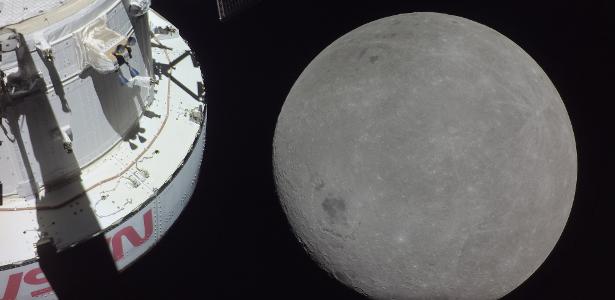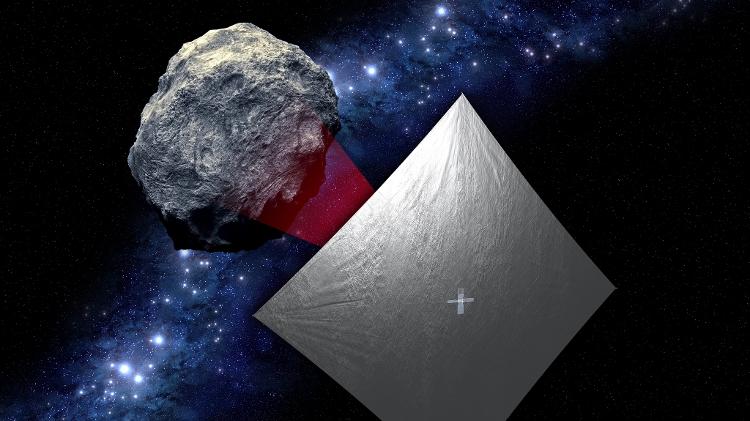Ten “CubeSats” harnessed the SLS rocket (Space Launch System or Space Launch System), which launched the Orion capsule into orbit around the Moon for a journey into space. These are nanosatellites, the size of a shoebox, which will carry out various scientific experiments.
They are of class 6U – U unit of measurement equivalent to a cube with an edge of 10 cm -, with 20 cm in height, 10 cm in width and 34 cm in length. Each weighs between 1 and 10 kilograms.
CubeSats were developed by NASA, from partner space agencies, universities, small and large aerospace companies and/or research institutes. Its objectives include studies of various aspects of the Moon and the Solar System and of new technologies for interplanetary travel.
Discover the function of the 10 nanosatellites launched with the Artemis 1 mission:
ArgoMoon
Developed by the Italian company Argotec, for the Italian Space Agency, its goal is to record images of the intermediate stage of cryogenic propulsion (ICPS extension) from the SLS rocket and later from Earth and the Moon. This information will be useful for planning future missions. Equipped with two high-definition cameras and advanced imaging software, it’s up and running and sending us beautiful images of the Moon.
BioSentinel
Developed by NASA’s Ames Research Center, it aims to measure the impact of space radiation on living organisms outside the Earth’s protective magnetosphere. For this it carries yeast cells, which have mechanisms similar to those of humans. It will be the first long-term biological experiment to take place in deep space and could help protect astronauts on farther journeys, such as future exploration of Mars.
Cusp
The ‘Solar Particles Study CubeSat’ (CuSP) will study the radiation and magnetic fields that flow from the Sun and can cause various effects on the Earth. It was jointly developed by the Southwest Research Institute in collaboration with NASA. Equipped with three instruments, it will orbit the Sun, and could be the first step towards creating a constellation of nanosatellites to constantly monitor space weather.
Knight
Developed by the University of Tokyo and the Japan Aerospace Exploration Agency (JAXA), it aims to measure the plasmosphere around the Earth, a region of our atmosphere that contains electrons and highly ionized particles that rotate with the planet. It will also study meteor impacts and the dusty environment around the Moon. The data will be important in protecting humans and electronics from radiation damage during longer space journeys.
MonIR
Using a miniature advanced infrared sensor, it will collect images and data about the lunar surface and its environment, including composition, thermal signatures, water presence and possible landing sites. It was funded by NASA and built by Lockheed Martin. This mapping of the Moon aims to protect astronauts from possible risks in future space missions.
Lunar ice cube
As its name suggests, its main job is to investigate lunar ice. It will also study the exosphere, the upper layer of the atmosphere, to understand the dynamics of water and other substances on the Moon. The information provided will help predict seasonal changes in lunar ice that could impact its use as a resource in the future. It is a collaboration between the University Moreheads Statea Busk Agency and at NASA.
Map MoonH
Its name means “Polar Hydrogen Lunar Mapper”. Developed by Arizona State University and sponsored by NASA, its mission is to measure the distribution and quantity of hydrogen at the South Pole of the Moon. It will produce a high-resolution map to reveal new details about the distribution of potential ice already identified by previous missions, such as in the crater. Shackleton🇧🇷 This will help us understand how water got there, how much might still be available, and how it might be used as a resource for longer exploration missions to the Moon.
NEA Explorer
The “near-Earth asteroid hunter” is a mini robotic reconnaissance mission, which will fly to the GE 2020 object and send us data (size, shape, rotation, surface properties, etc.). It is equipped with a solar sail — a propulsion system that uses solar radiation pressure — and a camera. 20 year old scientist megapixelsa NEAC extension🇧🇷 The data could help explain how asteroids formed and evolved, as well as contribute to planetary defense research. Developed by NASA.
Omotenashi
A tiny lander, which will detach from the nanosatellite, will be the only part of the Artemis 1 mission that will touch the surface of the Moon. Developed by Jaxa, tin order to test technologies and trajectory maneuvers that allow the landing of small modules on moons and planets. If successful, it will also measure surface radiation and investigate the mechanics of rocky soil using accelerometers.
Miles team
Developed by Miles Space, in collaboration with software developer Fluid & Reason, it intends to demonstrate that hybrid plasma and laser thrusters travel approximately 96 million kilometres, being the first spacecraft of this size to reach that distance (for comparative purposes the distance from Earth to Mars is about 54 million kilometers). It will also test a software radio for communication. But the big goal is to participate in NASA’s Deep Space Race.
It could be that some CubeSats have problems. So far, six of them have sent coherent signals to mission operators: Equuleus, LunIR, CuSP, LunaH-Map, ArgoMoon and BioSentinel; two others are operational, but with anomalies: LunIR and Omotenashi; and the latter two (NEAScout and Team Miles) have not yet managed to communicate with Earth.



